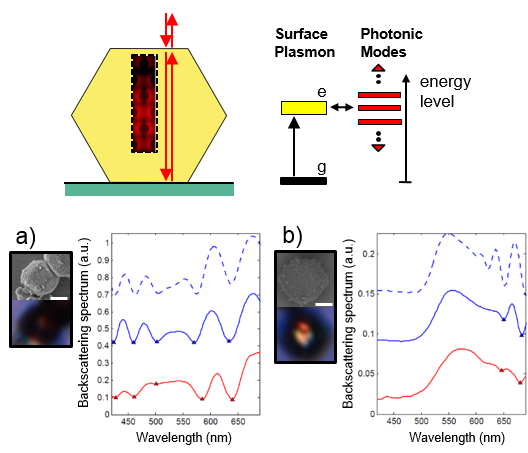Plasmonic Photonic Crystals Realized through DNA Programmable Assembly
November 26, 2014
Scientific Achievement
Tunability of strong light-plasmon interaction in 3D plasmonic photonic crystals is demonstrated with tailorable crystal lattice constants and nanoparticle diameters by a DNA programmable assembly technique.
Upper left: Schematic showing interaction between incident light and 3D array of plasmonic nanoparticles. Upper right: Energy level diagram of surface plasmons and photonic modes showing strong coupling of two modes.

Bottom: Backscattering spectra of two different types of crystals (see electron and optical microscope images) showing different strengths of light-plasmon coupling around surface plasmon resonance ~530 nm. (Red lines: experiment; blue lines: two different models, and scale bar is 1 µm).
Significance and Impact
This particular research opens up exciting possibilities for tuning the interaction between light and highly organized collections of particles at the nanoscale level for applications ranging from quantum electrodynamics to biosensing.
Research Details
- Micron scale, BCC gold nanoparticle crystals are synthesized by DNA programmable assembly technique with several different sets of crystal parameters.
- Supported by theoretical calculations, optical experiments show change in light-plasmon coupling strength among several different crystal types due to differences in their gold volume fraction.
Plasmonic Photonic Crystals Realized through DNA-Programmable Assembly
Park, D. J., Zhang, C., Ku, J. C., Zhou, Y., Schatz, G. C., Mirkin, C. A.
Proc. Natl. Acad. Sci. U. S. A. 112, 2015, 760-766.
Work performed at Northwestern University
